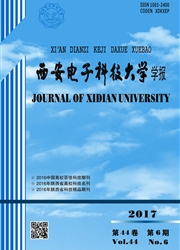

 中文摘要:
中文摘要:
针对多输入多输出空间相关信道环境,提出了一种基于格规约理论的最小均方误差检测算法.该算法考虑了空间相关性的影响,利用复数Lenstra-Lenstra-Lovász格规约算法克服了传统的线性最小均方误差检测器分集阶数随相关系数增加而减小的缺点,使检测到的信号在高信噪比下可以达到比传统算法低几个数量级的误码率.理论分析与仿真结果表明,在信道为Kronecker相关平坦衰落模型下,接收端采用最小均方误差信道估计,发射端采用QPSK调制未使用信道编码,当比特信噪比大于18dB时,基于格规约理论的最小均方误差检测器的误码率低于传统最小均方误差检测器的误码率;发射端采用(2,1,3)卷积码、接收端采用硬判决Viterbi译码,当信噪比大于16dB时,基于格规约理论的最小均方误差检测器的误码率低于传统最小均方误差检测器的误码率,且基于格规约理论的最小均方误差检测器的分集阶数不受相关系数的影响,等于接收天线数N.
 英文摘要:
英文摘要:
To overcome the drawback that the diversity order of the traditional linear MMSE detection algorithm decreases with the increase of the correlation coefficient,a lattice-reduction-aided MMSE(LRA-MMSE) detection algorithm is proposed for spatial correlated MIMO channels.The LRA-MMSE detection algorithm considers the effect of spatial correlation in the algorithm design and takes advantage of the complex Lenstra-Lenstra-Lovász(LLL) algorithm so that its BER(bit error rate) is several orders of magnitude smaller than that of the traditional linear MMSE detection at a high SNR(signal to noise ratio).Theoretical analysis and simulation results show that with QPSK modulation and the MMSE channel estimator at the receiver,the uncoded BER of the LRA-MMSE detector is lower than that of the traditional linear MMSE detector if the bit SNR(Eb/N0) is greater than 18 dB,while the coded BER of the LRA-MMSE detector is lower than that of the traditional linear MMSE detector if Eb/N0 is greater than 16 dB when(2,1,3) convolutional channel coding and Viterbi decoding are adopted under the Kronecker correlated flat fading channel.Furthermore,the diversity order of the LRA-MMSE detector in the correlated MIMO channel is equal to the number of the receive antenna N.
 同期刊论文项目
同期刊论文项目
 同项目期刊论文
同项目期刊论文
 Network lifetime optimization under QoS Constrains for coded cooperative networks by dynamic resourc
Network lifetime optimization under QoS Constrains for coded cooperative networks by dynamic resourc Optimal power control for cognitive radio networks under coupled interference constraints: A coopera
Optimal power control for cognitive radio networks under coupled interference constraints: A coopera 期刊信息
期刊信息
